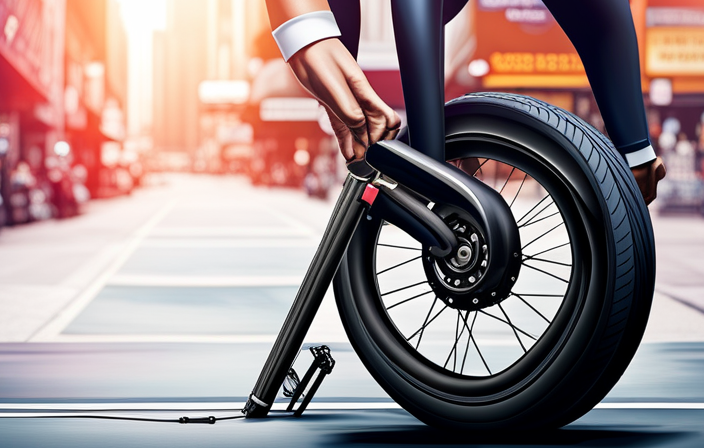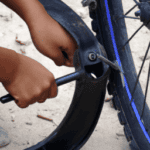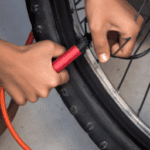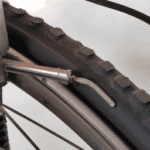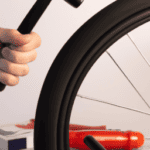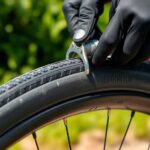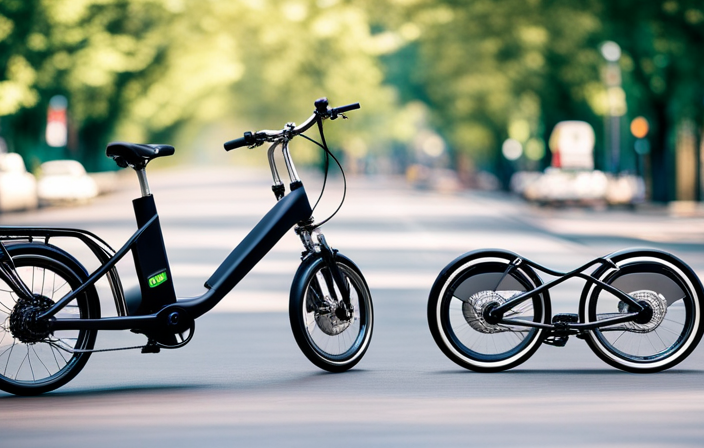They say that ‘preparation is key,’ and that is especially true when it comes to fixing a flat tire on your electric bike. Whether you are an experienced cyclist or a beginner, being able to effectively and promptly address this common problem can help you save time, money, and prevent frustration.
In this step-by-step guide, I’ll walk you through the process of fixing a flat tire on your electric bike, from gathering your tools to practicing at home, so you’ll be back on the road in no time.
Key Takeaways
- Regular tire pressure checks are important to prevent future flats and maintain the longevity and performance of the electric bike.
- Tire liners, puncture-resistant tires, and tubeless conversion can help prevent flat tires and enhance the overall ride quality.
- Removing and reinstalling the wheel involves loosening the brake caliper, releasing tension on the quick release lever or axle nuts, inspecting and reinforcing wheel spokes if necessary.
- Practice fixing a flat tire at home to familiarize yourself with the process, identify potential challenges, and develop techniques to prevent future flats.
Gather your tools and materials
You’ll need to gather your tools and materials before you can begin fixing a flat tire on your electric bike. Tire repair kits are essential for this task, as they contain all the necessary items to patch or replace the damaged tire. Additionally, it’s important to have some essential bike maintenance tools on hand, such as tire levers, a pump, and a wrench. These tools will help you remove the tire, replace the inner tube, and reattach the tire to the rim. Having these items readily available will save you time and ensure a smoother repair process.
Once you have gathered your tools and materials, you can move on to the next step: locating the flat tire.
Locate the flat tire
Locating the deflated wheel on your e-bike is like finding a hidden treasure. To start, ensure your bike is on a stable surface and turn off the power.
Begin by visually inspecting the tires for any obvious signs of damage, such as nails or glass shards. If you don’t find anything, inflate the tire slightly to identify the source of the leak. Once inflated, listen for any hissing sounds or feel for air escaping. If the cause is not immediately apparent, submerge the tire in water and look for bubbles, indicating the location of the puncture. Remember to take safety precautions, such as wearing gloves and eye protection.
Now that you’ve located the flat tire, it’s time to move on to removing the wheel from the bike.
Remove the wheel from the bike
To proceed, detach the wheel from your e-bicycle with caution.
- Start by flipping your bike upside down or propping it up on a sturdy stand.
- Use a wrench to loosen the nuts or quick-release lever that secures the wheel to the frame.
- Carefully lift the wheel off the bike, making sure not to damage any electrical connections or brake cables.
- Set the wheel aside on a clean surface, preferably with a soft cloth to avoid scratching.
Now that the wheel has been removed, it’s time to move on to the next step: deflating the tire completely. By removing the wheel, you’ll have a much easier time accessing the tire and inspecting it for any damage or punctures.
Deflate the tire completely
Once the wheel is safely removed, take a moment to release all the air from the tire. Allow it to deflate completely like a balloon losing its air. To deflate the tire, locate the valve stem on the inner tube and press down on the valve core with the tip of a valve tool or a small screwdriver. This will release the air from the tube. As the tire deflates, you may hear a hissing sound as the air escapes. Ensure that all the air is expelled from the tire before proceeding to the next step.
Now that the tire is completely deflated, it is time to move on to the next step. Inspect the tire for any punctures or damage.
Inspect the tire for any punctures or damage
Take a close look at the tire, scanning for any signs of punctures or damage. Start by visually inspecting the entire surface of the tire, paying close attention to the tread area. Look for any visible cuts, tears, or foreign objects embedded in the tire. Run your fingers along the tire to feel for any sharp objects that may have caused the puncture.
Additionally, check the sidewalls for any bulges or cracks, as these can indicate tire damage. It is important to inspect the tire thoroughly to ensure that all potential sources of punctures or damage are identified.
By regularly inspecting your tire and practicing puncture prevention techniques such as avoiding sharp objects and maintaining proper tire pressure, you can minimize the chances of future tire damage.
Moving forward, let’s now discuss how to patch or replace the inner tube.
Patch or replace the inner tube
Before delving into the delicate dance of mending or swapping out the inner tube, let’s explore the intricate workings that lie beneath the surface of your trusty two-wheeled companion. When it comes to fixing a flat tire on an electric bike, there are two main options: patching the inner tube or replacing it altogether.
To help you make an informed decision, here are a few things to consider:
-
Patching Techniques: Patch kits are widely available and can be used to seal small punctures in the inner tube. This involves locating the hole, cleaning the area, applying adhesive, and affixing the patch. It’s important to follow the instructions carefully for a successful repair.
-
Tube Replacement Options: If the inner tube is too damaged or the puncture is too large to be patched, it may be necessary to replace the tube. You can either buy a new tube or consider using a puncture-resistant tube for added durability.
Now that you have a better understanding of patching techniques and tube replacement options, let’s move on to the next step of reinflating the tire to the recommended pressure.
Reinflate the tire to the recommended pressure
Now that you have a better understanding of how to revive your ride and give it the perfect amount of bounce, it’s time to pump up the tire with the recommended pressure for an exhilarating ride.
Start by attaching the nozzle of a bike pump to the valve stem of the inner tube. Ensure that the pump is securely connected to avoid any air leakage. Begin pumping the handle of the pump in an up and down motion. Keep an eye on the pressure gauge to monitor the progress.
Inflate the tire to the recommended pressure, which can usually be found on the sidewall of the tire or in the bike’s manual. Once the tire is fully inflated, remove the pump and quickly close the valve stem to prevent any air from escaping.
With the tire properly inflated, you can now move on to reinstalling the wheel onto the bike, ensuring a smooth and safe ride.
Reinstall the wheel onto the bike
Once you’ve successfully pumped up your tire to the recommended pressure, it’s time to reattach the wheel onto your trusty two-wheeled companion for an effortless and enjoyable ride. To reinstall the wheel, ensure that the axle slots into the dropouts on the frame. Align the disc brake rotor with the caliper and slide the wheel all the way in until it sits snugly. Now, tighten the quick-release lever or axle nuts, depending on your bike’s design, making sure the wheel is securely fastened. To check for proper alignment, spin the wheel and observe its rotation. It should spin freely without any wobbling or rubbing against the brake pads. Once you’re satisfied with the wheel’s alignment, you can proceed to the next step: testing the tire for proper inflation and alignment without writing ‘step’.
Test the tire for proper inflation and alignment
To ensure a smooth and balanced ride, you’ll want to check that your tire is properly inflated and aligned. Here’s how you can test the tire for proper inflation and alignment:
-
Test for leaks: Inflate the tire to the recommended pressure using a bike pump. Apply a mixture of soapy water to the tire surface and look for bubbles. If bubbles appear, there might be a leak that needs to be patched.
-
Check tire pressure: Use a tire pressure gauge to measure the air pressure in the tire. Compare it to the recommended pressure stated on the sidewall of the tire. If the pressure is too low, add air. If it’s too high, release some air until it reaches the proper level.
-
Inspect alignment: Spin the tire and observe if it wobbles or rubs against the brake pads. If there is any misalignment, adjust the wheel by loosening the axle nuts and repositioning the wheel until it spins freely without any interference.
-
Test the tire again for leaks: Repeat the bubble test after aligning the wheel to ensure that the adjustments didn’t cause any leaks.
By following these steps, you can ensure that your tire is properly inflated and aligned for a safe and comfortable ride.
Remember to check the tire pressure regularly to prevent future flats.
Check the tire pressure regularly to prevent future flats
Make sure you regularly check your tire pressure in order to avoid getting stranded with a deflated tire. Preventive measures, such as checking tire pressure regularly, are crucial for maintaining the longevity and performance of your electric bike.
Proper tire pressure is essential for a smooth and safe ride. It not only affects the bike’s handling and stability but also helps prevent future flats. Maintaining the correct tire pressure ensures optimal traction and minimizes the risk of punctures caused by hitting sharp objects on the road.
By regularly monitoring your tire pressure, you can identify any deviations from the recommended levels and address them promptly. This simple yet important task can save you from potential inconveniences and additional expenses.
Moving forward, considering the use of tire liners or puncture-resistant tires can further enhance your electric bike’s flat tire prevention.
Consider using tire liners or puncture-resistant tires
If you want to ensure your ride is as smooth as gliding on a cloud, consider using tire liners or puncture-resistant tires. These options can greatly reduce the chances of getting a flat tire on your electric bike.
Here are three ways you can achieve this:
-
Tire sealant: Apply a tire sealant to the inside of your tire. This liquid substance fills in any small punctures or holes, preventing air from escaping and keeping your tire inflated.
-
Tubeless conversion: Convert your tires to a tubeless setup. This involves removing the inner tube and using a special rim tape to create an airtight seal. With this setup, you eliminate the risk of pinch flats and reduce the chances of getting a puncture.
-
Puncture-resistant tires: Invest in high-quality tires that are specifically designed to resist punctures. These tires often have a thicker tread or additional layers of protection to prevent sharp objects from penetrating the tire.
By using tire liners or puncture-resistant tires, you can greatly minimize the likelihood of getting a flat tire on your electric bike.
In the next section, we will learn how to remove and reinstall the wheel quickly and efficiently, ensuring you can tackle any tire-related issues with ease.
Learn how to remove and reinstall the wheel quickly and efficiently
Removing and reinstalling the wheel swiftly and skillfully ensures smooth and hassle-free maintenance of your ride.
To start, loosen the brake caliper and release the tension on the quick release lever or axle nuts.
Next, lift the bike onto a stand or turn it upside down to access the wheel easily. Use a wrench to loosen the axle nuts or release the quick release lever, then carefully slide the wheel out of the dropouts.
Now, if you’re using tubeless tires, deflate them completely before attempting to remove the wheel.
Once the wheel is out, take this opportunity to inspect and reinforce wheel spokes if necessary.
To reinstall the wheel, reverse the steps, making sure the wheel is properly aligned and securely fastened.
By mastering this process, you’ll be ready to practice fixing a flat tire at home before you encounter one on the road, ensuring a seamless riding experience.
Practice fixing a flat tire at home before you encounter one on the road
Now that you know how to remove and reinstall the wheel quickly and efficiently, it’s time to put your skills to the test.
Practice fixing a flat tire at home before you encounter one on the road. This will not only help you become more proficient in the process, but it will also give you the confidence to handle any flat tire situation that may arise during your rides.
Start by gathering all the necessary tools and materials, including a spare tube, tire levers, and a bike pump. Follow the step-by-step instructions we previously discussed, taking your time to ensure you understand each step.
By practicing at home, you can familiarize yourself with the process, identify any potential challenges, and develop your technique to prevent future flats.
Now that you’re prepared, let’s move on to the next section and learn about carrying a portable tire pump or CO2 inflator with you on your rides.
Carry a portable tire pump or CO2 inflator with you on your rides
Make sure to always have a portable pump or CO2 inflator with you on your rides so that you can quickly and efficiently inflate your tires in case of an emergency.
Here are three important things to consider when carrying a portable pump or CO2 inflator:
-
Carrying spare tubes: It’s a good idea to bring along extra inner tubes that are compatible with your electric bike’s tire size. This way, if you encounter a puncture that cannot be repaired on the spot, you can simply replace the tube and get back on the road.
-
Using tubeless tires: If your electric bike is equipped with tubeless tires, carrying a tube may not be necessary. However, it’s still essential to have a portable pump or CO2 inflator to re-inflate the tire in case it loses air pressure.
-
Consider joining a local bike repair workshop: Learning more advanced maintenance skills can help you handle more complex issues, such as fixing a flat tire that cannot be resolved with a spare tube or inflator.
By being prepared with the right tools and knowledge, you can confidently handle flat tire situations and continue enjoying your rides. Consider joining a local bike repair workshop to learn more advanced maintenance skills.
Consider joining a local bike repair workshop to learn more advanced maintenance skills
Considering joining a local bike repair workshop is like unlocking a treasure chest of knowledge that will empower you to conquer any maintenance challenge on your two-wheeled companion. These workshops offer a wealth of information on advanced maintenance skills that go beyond fixing a flat tire. You will learn how to properly adjust gears, replace brake pads, true a wheel, and even rebuild a bike from scratch. The table below provides a glimpse into the wide range of topics covered in such workshops:
| Workshop Topic | Description |
|---|---|
| Gear Adjustments | Learn how to fine-tune your gears for smooth shifting and prevent chain slippage. |
| Brake Pad Replacement | Master the art of replacing worn-out brake pads to ensure optimal stopping power. |
| Wheel Truing | Discover the technique of aligning a wobbly wheel, enhancing stability and ride comfort. |
| Bike Rebuilding | Gain the skills to completely disassemble and rebuild your bike, including frame alignment and component fitting. |
| Advanced Diagnostics | Learn to troubleshoot complex issues like bottom bracket noise, headset play, and drivetrain malfunctions. |
By attending these workshops, you’ll not only become self-sufficient in maintaining your electric bike but also gain the confidence to tackle any mechanical challenge that comes your way.
Frequently Asked Questions
How often should I check the tire pressure on my electric bike?
I check my electric bike’s tire pressure every two weeks to ensure optimal performance. Regularly checking tire pressure helps maintain proper inflation, which improves traction, reduces rolling resistance, and extends tire life.
Are there any special tools or materials needed to fix a flat tire on an electric bike?
To fix a flat tire on an electric bike, you’ll need special tools like tire levers, a patch kit or spare tube, and a pump. These materials, along with your electric bike, are essential for successfully repairing a flat tire.
Can I use a regular patch kit for the inner tube of an electric bike tire?
Yes, you can use a regular patch kit for the inner tube of an electric bike tire. However, there are alternative repair methods. The pros of using a regular patch kit include affordability, but the cons include potential issues with the thicker inner tubes of electric bike tires.
Are there any specific safety precautions I should take when removing and reinstalling the wheel on an electric bike?
When removing and reinstalling the wheel on an electric bike, it is important to handle the battery properly. Additionally, make sure the motor is disengaged before starting any work on the wheel.
How long does it usually take to fix a flat tire on an electric bike?
Fixing a flat tire on an electric bike usually takes me around 15-20 minutes. To do it efficiently, I recommend having the necessary tools ready, removing the wheel carefully, and patching or replacing the tube.
Conclusion
So there you have it, a step-by-step guide on how to fix a flat tire on an electric bike. By following these instructions and being prepared with the right tools and materials, you can easily handle this maintenance task on your own.
I know it may seem daunting at first, but with a little practice and preparation, you’ll be able to fix a flat tire with ease. And remember, even if you encounter a flat tire on the road, having a portable tire pump or CO2 inflator with you can save the day.
Don’t let the fear of a flat tire hold you back from enjoying your electric bike rides. With a little knowledge and preparation, you’ll be back on the road in no time.
